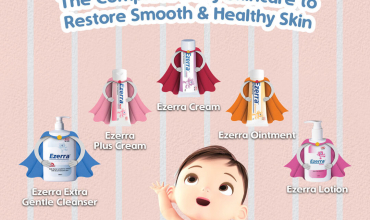Everything You Should Know About Dry & Irritated Baby Skin
Affecting 1 out of 5 children worldwide, dry and irritated skin condition is indeed a very real issue to plague parents. Frequently seen in babies with a family history of a similar condition, it is often characterised as itch and irritation on the skin where redness may occur.
However, not all hope is lost. Parents may find relief in the fact that it usually only persists through childhood and adolescence for certain cases, so keep your chin up!
What Causes Dry & Irritated Baby Skin?
To this day, doctors are still unsure of the exact cause of dry and irritated skin condition, but concluded that it may be a combination of genetic and environmental factors.
Moreover, babies are easily affected by dry and irritated skin condition due to their natural biological skin structure. Having a significantly thinner composition compared to an adult’s skin, this results in baby skin losing moisture nearly twice as fast as an adult.
What Are The Early Signs & Symptoms?
Appearing more prominently on the cheeks and forehead within the first few months, early symptoms may also form around the diaper area of an infant. Common signs to look out for include itching and dryness of the skin, accompanied by the occasional scaly and weepy appearance with patches of irritation.
What Are The Triggers?
One important thing to understand about dry and irritated skin is that it’s not a persistent condition. As such, it’s normal to have periods that are free of symptoms and the occasional flare-ups when the condition is triggered, resulting in irritation and worsening of symptoms.
Just like the saying goes, prevention is better than cure. The key to keeping this condition under control is knowing the common triggers and learning how to limit or avoid exposure to these triggers. The triggers listed below may include a variety of allergens and irritants, such as:
Harsh soaps: This category includes bubble baths, scented baths and products containing SLS/SLES. Use mild skin cleansers or shampoos instead that are specially made for sensitive baby skin.
Pets: Avoid any pets with long fur or excessive dander that will make the itch worse.
Food: Allergenic food such as peanuts, soy and eggs may cause severe itching for certain individuals, so be sure to take extra precaution.
Wool: Avoid wool and synthetic fibers where the material feels scratchy and rough on the skin.
Dry Air: If the air in your home is dry or you constantly turn on the air-conditioner, use a humidifier to add moisture to the surroundings.
How to Manage Dry & Irritated Skin?
Daily management becomes a vital everyday routine. At the end of the day, you’ll be surprised at how a few seemingly regular tips can contribute greatly to your baby’s long-term skin health.
1. Practice shorter bath times
Bad news for parents who love bath times with their little one — lengthy baths have been proven to cause more harm to a baby’s sensitive skin as prolonged contact with water may leave it prone to irritation. An easy tip to monitor your bath time is to keep an eye out for their skin; if it has gone wrinkly and pruney, that’s a sign that they’ve been in the water too long.
2.Lotions and moisturisers are your baby’s best friend
The trick to locking moisture for a longer period of time? Slather it on right after your baby’s bath! At this time, the skin still holds some moisture from the bath and has not evaporated due to the external environment.
After a bath, gently wipe down your baby with a cotton towel and apply a generous layer of lotion while the skin is still slightly damp. That way, the skin is able to “lock” the remaining moisture in the cells for prolonged hydration.
3.Dress your baby in soft cotton clothing
It’s important to pick clothes that do not cause further irritation to your child’s skin. Your best option? Cotton! Today, cotton is regarded as the gold standard for sensitive skin-friendly fabric. With a gentle and breathable texture, this fabric has cooling properties that feels smooth to the touch and prevents overheating of the skin.
4.Keep your child’s fingernails short
Scratching may seem to provide temporary relief, but habitual scratching can pose a more dangerous threat. It may damage and “break” the skin, leading to increased redness and potential exposure to bacteria.
However, the question remains — how do you discourage a natural response to itch such as scratching? The simple answer is, you most probably can’t. However, there are ways to get around this unhealthy habit, such as keeping your child’s nails trimmed and short at all times. It has been shown that short fingernails greatly reduces flare-ups associated with scratching, so do take note!
Of course, you are never alone on this difficult journey, with Ezerra,









